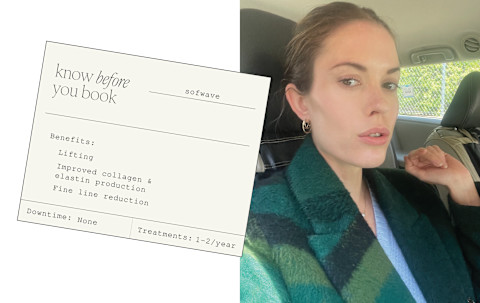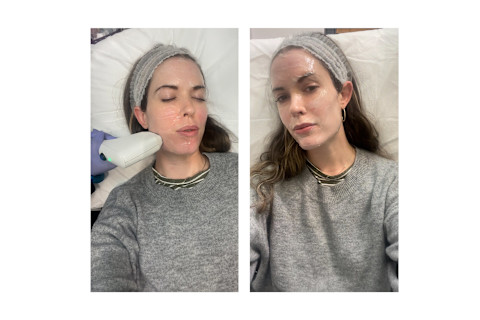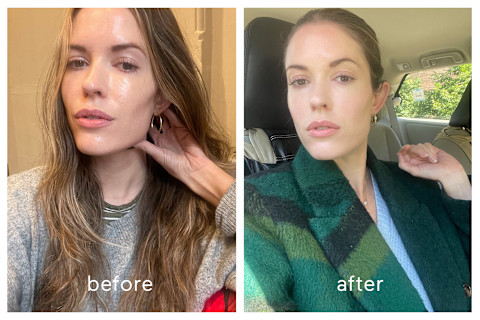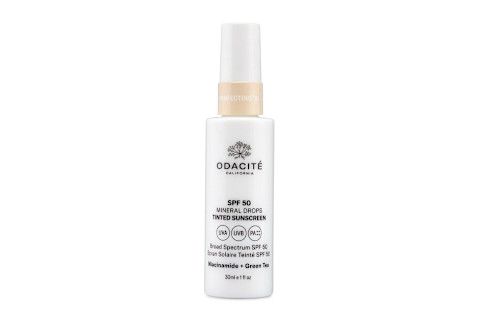Know Before You Book: Everything You Need To Know About Sofwave, The Collagen-Boosting In-Office Treatment

If I'm going to be honest with you, I sometimes get a tingle of anxiety that I haven't yet gone down the injectable route. I'm in my early-to-mid 30s, work in the beauty industry, and live in New York City—which is to say that most people I know are already a few years ahead of me.
Of course, I don't think there's anything wrong with filler or neuromodulators. (I know they make a lot of people happy!) However, I just am not at a place in my life where my skin has given me so much concern that I've called up a dermatologist asking for an appointment and a syringe. But here's where the anxiety sets in: I don't want a decade to pass and end up regretting not having done it. There's so much conversation around "preventive" measures that a small part of me fears waking up one day and I'm the only person I know with a wrinkle.
What makes this even more out of character is that I actually find wrinkles to be quite alluring and sexy. I love the look of a face that's been lived in, and don't dread wrinkles. I don't mind aging, I just don't want to feel like I'm the only one who's doing so.
Unfortunately, I don't have a solution to this juxtaposition of feelings, and maybe I never will!
But what I can tell you is that recently I've started researching alternative in-office procedures—ones that work with your skin to improve the regenerative process. Luckily for me, it's an area that's ripe for exploring. There are so many emerging technologies that can help improve the natural rejuvenation process, helping your complexion look its best for longer. And what I really appreciate about them is that they're not changing the skin or the face, just optimizing its healing potential.
One such treatment is Sofwave, which I tried about three months ago. Here's everything you need to know.

What is sofwave?
Sofwave is a skin treatment that uses ultrasound technology to stimulate collagen and elastin production. I'll explain how it does that in a second (along with what makes it so novel compared to other ultrasound devices), but I'd first like to give a brief overview of why we target collagen and elastin in the first place.
Collagen and elastin are your skin's primary structural proteins. Collagen keeps skin firm and lifted, while elastin gives skin its spring, stretch, and suppleness. Together, they're responsible for many of the characteristics we associate with healthy, vibrant skin. At some point in the mid-20s, the balance of how much the skin produces versus how much is lost tips—and not in our favor. At this point, our natural supply of both declines, and we start to see many of the visible signs of aging, such as sagging skin and fine lines.
So much of what we do in skin care is geared toward revitalizing that production—so our skin looks and feels like it might've in our early 20s.
Which brings me back to sofwave. "After age 25, our collagen production goes down. Anything we can do to get that collagen production back up and turn that whole physiology back on, is a good thing. There are a lot of technologies that can improve collagen production in that dermal layer, but they all have downtime. With this, you can go back to life quickly after," says board-certified dermatologist Amy Lewis, M.D., Clinical Associate Professor of Dermatology at Yale University School of Medicine.
Lewis explains to me that it uses seven parallel beams that bypass the epidermis (the surface of the skin) and enter the mid-dermal layer. This is where collagen and elastin are made, so it more effectively supports their production.
This isn't the first ultrasound treatment to hit the market, but it is the most sophisticated. "With the way that the energy enters into the skin, it's more effective than ultrasound therapies of the past. It's a fixed depth, so it's only targeting the dermal layer where the collagen and elastin is being produced," says medical assistant Rebecca Manzi at the office of Amy B Lewis M.D.
The treatment is approved for the full face (with a focus on brows and jawline in particular), neck, chest, and on the body (to help with cellulite). It has no downtime whatsoever, but you will have to wait one to three months before you start to see results, with the full benefits at about the six-month mark. It's recommended for once-yearly treatments, but that's really up to you and your dermatologist.
Oh, and it's pricey: Depending on the amount of surface area you're treating and the practitioner you go to, it will cost you anywhere between $1,500 to $4,500. A full face (which is what I got) starts at $2,500.
For full disclosure, mine was comped since I'm a beauty journalist—however, it came with no strings attached. What you're reading here is my honest assessment of the experience.
4 benefits of sofwave
Here, what you can expect from a treatment depending on where you're getting it:
Collagen & elastin production
Sofwave works by improving collagen and elastin production. Unlike other ultrasound technologies that aren't as exacting, only targets the mid-dermis where the collagen and elastin are produced. The ultrasound energy heats the area, triggering a wound response. With this isolated wound response, collagen and elastin floods the area.
As we've noted, collagen and elastin production start to decline in the mid-20s. "Essentially, you're turning on the faucet on things that have started closing," Lewis says, noting that the treatment acts more like a reset than a fix. "Most of the benefits are overtime. You're looking in the mirror and just getting younger and younger."
Lifting & wrinkle reduction
Collagen and elastin loss are the driving force behind sagging and wrinkles. Thanks to its ability to remodel collagen and elastin, skin is lifted and fine lines are smoothed.
"In your skin, you have different layers of things—collagen, elastin, and so on. As we get older those layers don't lay flat and become hardened, which is why we get wrinkles," says Lewis, noting that this helps remodel those so it evens out the fine lines.
"Lots of people come in and don't want surgery, but want help treating wrinkles. I'm not going to promise surgical results, but we can help improve the area. So this is perfect for people like that," she says.
Reduces the appearance of cellulite
Recently, the technology was just approved for the treatment of cellulite. According to the brand, the ultrasound technology helps "generate the growth of elastin and collagen fibers, which cause the skin to tighten and improve skin laxity, which leads to the improvement of the appearance of cellulite."
Brow & jawline lift
According to Lewis, the brows and jawline are the two most popular areas of treatment. For both areas, there are a few routes to take that can treat the area, but this is one of the only noninvasive methods that requires no downtime.
With age, the brows are a common area that starts to sag. "You can tailor what the person wants so well. Some people just want a brow lift—they're noticing that their brows have sagged and only want to target that area. We see people in their 30s asking for this. You can get that done really easily in 15 minutes," she says.
For older folks, the attention turns south. "For people in their 40s and 50s, a big thing is lower face and jawline. As people get older into their 40s, it's the lower face that sees the most sagging. So we get a lot of people who want to target that area," she says.
What to expect
I had heard from fellow beauty editors and insiders about their experiences with Sofwave, so I knew beforehand that I should expect some level of discomfort.
In fact, model and actress Veronica Webb described it to me as, "It feels like these hot pulses, almost like you're briefly touching the stove. I've heard it described as a 'hot stone massage,' but unless you've had natural childbirth in the woods, you probably wouldn't describe it as that. But I like it because there's no downtime."
I'm a firm believer that the best thing you can do before any beauty treatment is to educate yourself on what you're getting into. Here's my experience so you know if it's the right fit for your needs.

Before
I got to my appointment makeup-free and ready to go. I was taken to Lewis' treatment room and asked about what exactly I was looking to get out of this. I explained I'm in my early 30s, have relatively healthy skin, but was looking for an overall collagen boost in my face.
We decided to treat the full face, so I was slathered with numbing cream from my hairline to the jawline. Numbing creams become more effective the longer it's left on, so we did 40 minutes—however, the time range could be as short as 15 minutes to a full hour.
"There are different routes the specialist can take to help reduce the pain," Lewis told me, noting that they can numb the skin for longer, use nitrous gas, or even inject local anesthetic to block the more sensitive nerves. I suggest speaking up if you know that you have a lower threshold for pain, as your treatment provider can ensure they're taking the right steps to make sure it's as comfortable as possible.
There are also reports that it can trigger cold sores—so if that's a concern for you, take the appropriate preventive measures.
During
My practitioner, Manzi, showed me the machine, which had a curved rectangle tip a few inches in length. When touched to the skin, that tip delivers the energy waves into the dermis. The order of the treatment could vary depending on the practitioner, but for me Manzi explained that we'd do my face in zones: Left, right, forehead. Within the zones, she took my skin in smaller sectioned strips—doing horizontal passes, where she would stop every few inches. Just before we began, she handed me two stress balls.
I got a little overconfident with the first few zaps. After giving the outer corners of my jawline a quick pass, Manzi stopped to ask how I was doing. I don't even feel it, I chirped back. Boy, would that change!
At a spot just before my chin, the sensation started kicking in. Burning is the closest sensation I can liken it to. Like you've accidentally touched a curling iron to your skin, and it takes you a second before you notice the rush of pain. But because it was targeting the dermis, it was almost like the burning was emanating from the inside, out. The stress balls started making a whole lot of sense.
I soon came to discover that there were areas that were more painful than others, and that was likely because it was near or on a nerve ending or just over bone. The fleshier parts—the ones plump with fat pads, like the cheek—I could deal with no problem. But around the lips, eyes, and forehead were the most aggressive.
The entire process took about 45 minutes. Despite being painful in the moment, there’s no residual discomfort after the fact. Other than a slight irritation (I have very sensitive skin), my skin looked more or less like it always does.
After
Immediately following, I applied a gentle face cream, tinted moisturizer, brushed up my brows, and went back to work. There is minimal downtime to this treatment—skin looks no different before or after.
For the next several days and weeks, I waited patiently to see my slow complexion transformation. I knew I wouldn't see it for at least one month, so in the meantime I utilized skin care products (like the below) that help optimize collagen production.
"All of my patients have a skin care routine. I put them on something that's going to help support their collagen, whether it's a retinol or an antioxidant serum. And of course, sunblock, sunblock, sunblock," says Lewis. "A healthy lifestyle. Inside out, and outside in. I think people who want to look better are usually more invested in their health."
Personally, I use a vitamin C serum, peptide-infused cream, and a tinted mineral sunblock.
Other than that, I didn't do much for post-care. The procedure itself may be painful, but everything preceding and following it is nearly effortless.
Results
I got it in mid-March, which just now puts me at the three-month mark—when I'm at the height of my return on investment. As you can see from the photo, there are certainly aesthetic benefits to note: I look more lifted, toned, and refreshed. The fine lines on my forehead aren't whipped away, but they've smoothed out considerably. My eyes don't look so exhausted.
No one tells you this as you get older, but it's not just aesthetic changes that happen to your skin: There are also noticeable differences in how it acts. It takes longer for skin to recover, like creases from the pillowcase seem to stick around longer, and it's more finicky to environmental stressors.
It's like I've turned back the clock several years—my 32-year-old skin cells now operating at a level of a 25-year-old. It snaps back quicker, doesn't look so sallow at the end of a long day, and it feels more supple when I wash it.
People have been asking what I've been using lately because I just look more "refreshed." With things like neuromodulators or fillers, there are tangible and noticeable differences—all of a sudden the lips are more voluminous or the forehead lays flat. But with this treatment, it's less obvious. Folks just suspect I've been getting more sleep or trying a magical new retinol.

Who it's best for & who shouldn't get it
Not every treatment is for everyone—and you shouldn't rush out to try something just because someone says it's new and buzzy. And certainly the price tag on this treatment makes it cost-prohibitive for many folks.
The first thing to note is that it's safe for any skin type and tone. This is notable as many in-office procedures usually have major caveats on who can and can't use it. For example, IPL devices and certain lasers aren't suitable for those with darker skin tones as they may cause hyperpigmentation or scaring. Or microneedling isn't ideal for those with acne-prone skin. But sofwave can be used on skin from pale to dark and dry to oily.
But just because a product is safe for use, does not automatically mean you should rush to book it. It's important to consider what your goals are and if the intended procedure lines up with them. It's a healthy aging treatment that focuses on collagen and elastin production, so it's ideal for anyone who is starting to worry about fine lines, sagging, and loss of firmness.
More specifically, it's recommended for:
- Anyone in their 30s, 40s, and 50s who would benefit from a collagen boost and overall lift
- Folks experiencing sagging around the jowls and neck
- Those who want to slightly lift their brows
- People who want to tighten cellulite
And while it's safe for all skin types, there are folks that sofwave may not be the most worthwhile for their time and money.
- Those with a low pain tolerance should avoid this. The idea that "beauty is pain" is trite and outdated. If you don't want to be uncomfortable for even a second for the sake of collagen production, don't!
- While it's safe for all ages, people in their 20s still have pretty active collagen production so this wouldn't be worth it. Please, enjoy (and protect!) your precious collagen while you have it, my dears.
- This can help people 60+ who are experiencing serious sagging, but it won't entirely get rid of it. More intensive measures may be needed for dramatic results.
- This doesn't help treat dark spots, lasers and other resurfacing treatments may be a better fit for those dealing with pigmentation concerns.
FAQ
Does Sofwave really work?
Sofwave is an ultrasound technology that utilizes seven parallel beams of energy that are able to bypass the epidermis to target the mid-dermis, where collagen and elastin are produced. It has been FDA-approved for brow lifts, sagging along the jawline, and treating the appearance of fine lines.
How much does a Sofwave session cost?
Sofwave ranges from $1,500 to $4,500 depending on the practitioner and surface area done per session. A full face and neck starts at $2,500 per session.
Is Sofwave better than Morpheus?
While they're both effective at helping reduce the appearance of fine lines, Sofwave requires fewer treatments and lasts longer than Morpheus.
The takeaway
For those looking for a collagen reset, with minimal downtime, Sofwave is an effective solution. You may not see results for a full month after, but I found it to be worth the wait. Just be prepared to deal with pain during the treatment, and speak to your practitioner about ways you can limit discomfort.
And ultimately, this treatment won't help you skip the aging process altogether—your skin will still wrinkle and develop fine lines with time. However, you'll still look like you, just more refreshed and rejuvenated for longer.



